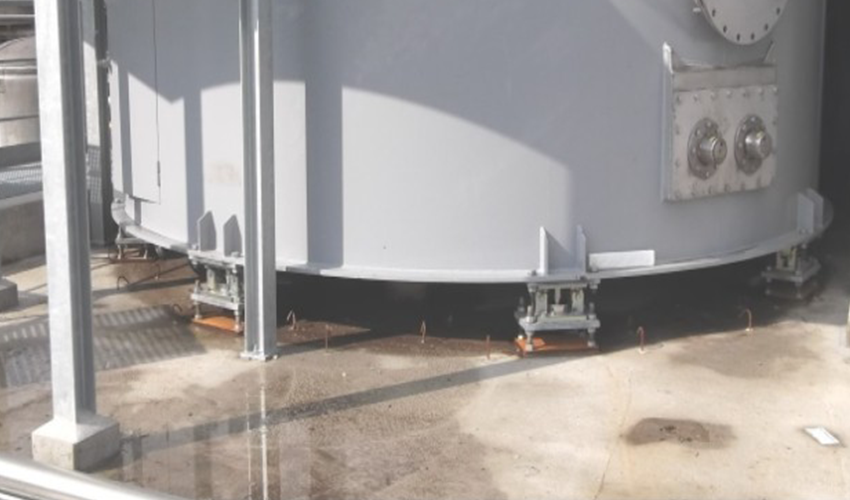Safe Silo Weighing

Silos store large quantities of bulk material, often high in value. In order to ensure a constant uninterrupted supply to a production process, it is essential to have an accurate reading of material level/weight in the silo.
Unlike low-viscosity liquids and gases, bulk solid products have characteristics that can make them difficult to accurately measure the level of, e.g. with some products bridges can form or the product can be unevenly distributed in the silo.
With some materials the density can also vary, making it even more difficult to determine the mass of raw material utilising the product level.
For cases such as this, weighing the silo is a particularly good way of ensuring accurate fill level control. To achieve this, the silo is mounted on load cells and therefore measures the mass of the product regardless of its position and distribution in the silo.
With the loadcells integrated into the structure of the silo, the question is how this can be done safely. The weighing becomes part of the silo structure and so its structural integrity needs to be considered and taken into account.
Scaime has developed solutions that simplify this process making it easier to construct a silo weighing system, tO meet the requirements of the project.
Design and construction
During the design and construction phase, the structure of the silo is designed or checked in such a way that the safety of the entire design is not compromised and optimal weighing results are achieved.
Of particular importance here are:
- The dead load of the silo
- The capacity in tonnes, or volume and specific weight of the material
- The location – inside/outside
- Wind loading and resulting forces
- Special conditions such as earthquake zones or other hazards to people
During the design phase, pre-calculated structural reports for the silo are used to determine the required safety forces for the weighing mounts and load cells. These calculations can include forces exerted on the silo by external factors such as wind loading, snow and earthquakes.
Using this data and the pre-calculated design verifications of the loadcell mount assembly according to EN1993 by the TÜV Süd, a decision regarding the most suitable weighing system for the application can be made. Checking the design of the weighing mount assemblies is an essential part of the safety consideration and will save time in the construction of the silo weighing system.
Installation

When installing an industrial weighing system, it is important that the work can be done quickly and safely. Site Labour time is expensive and efforts need to be made to keep stoppages during the installation process to a minimum.
Silosafe weighing kits simplify the installation process and include various features to ensure a smooth process:
Mounting the mechanics
- The Silosafe mounting kits can be mounted without load cells. This is important because after mounting the mechanics, welding work often has to be carried out which can damage the load cells electrically.
- No so-called dummy load cells, i.e. load cells without function, are necessary to ensure mechanical integrity. This feature saves costs and time.
- To install the load cells, simply insert them into the mounting kits. The silo can then be lowered onto the load cells via integrated lowering function of the Silosafe load kits. Static safety is permanently ensured during this process by the mounting kit.
- Silosafe Mounting kits already come assembled and set up and just need to be put in place without additional setting up or mounting work needed on site
Operation and maintenance
Operating a silo with a weighing system is low-maintenance and requires little attention. The R10X load cells used in the Silosafe mount provide IP68 protection class as standard and are therefore fully encapsulated. Should a measurement cable be damaged, the load cell can be replaced without interfering with the mounting kit and thus the construction of the silo. During the replacement process, the safety of the silo is constantly ensured by the mounting kit.
For more convenience the R10X load cells are available with M12 connectors, simplifying the replacement of the load cell. In this case, the connection cable is able to be replaced without having to remove the load cell. Different cables and cable lengths are compensated by the 6-wire connection.
Having a connector on the load cell also has the advantage that it is simple to use special cables, e.g. for optimum compatibility with chemical substances.
Compliance with EN 1090
The Construction Products Regulation (N°305/2011), which applies in Europe, states that the load-bearing elements of metal structures of buildings must comply with the EN1090 standard and be CE marked. In relation to silo weighing, Silosafe kits can be considered in applications subject to the EN1090 regulation as follows:
- The building owner defines a performance class (EXC) to which the manufacturer must respond according to the type of building and the human and material risks in case of failure.
- Depending on the performance class, the EN1090 standard describes the design, manufacturing and implementation requirements applicable to the product
In order to meet this requirement, SCAIME has had its quality system certified to EN1090 in performance class EXC2. This class ensures that the complete process, from product design to delivery, must be covered by a qualified and documented Quality Management system.
An EN1090-certified installation kit of class EXC2 provides the assurance of:
- A quality documentation system
- A non-compliance handling procedure
- Load capacity dimensioned according to the EN1993-1 standard
- Traceability of the materials used
- The Product meeting specifications
- Manufacturing carried out by qualified welders and workers
